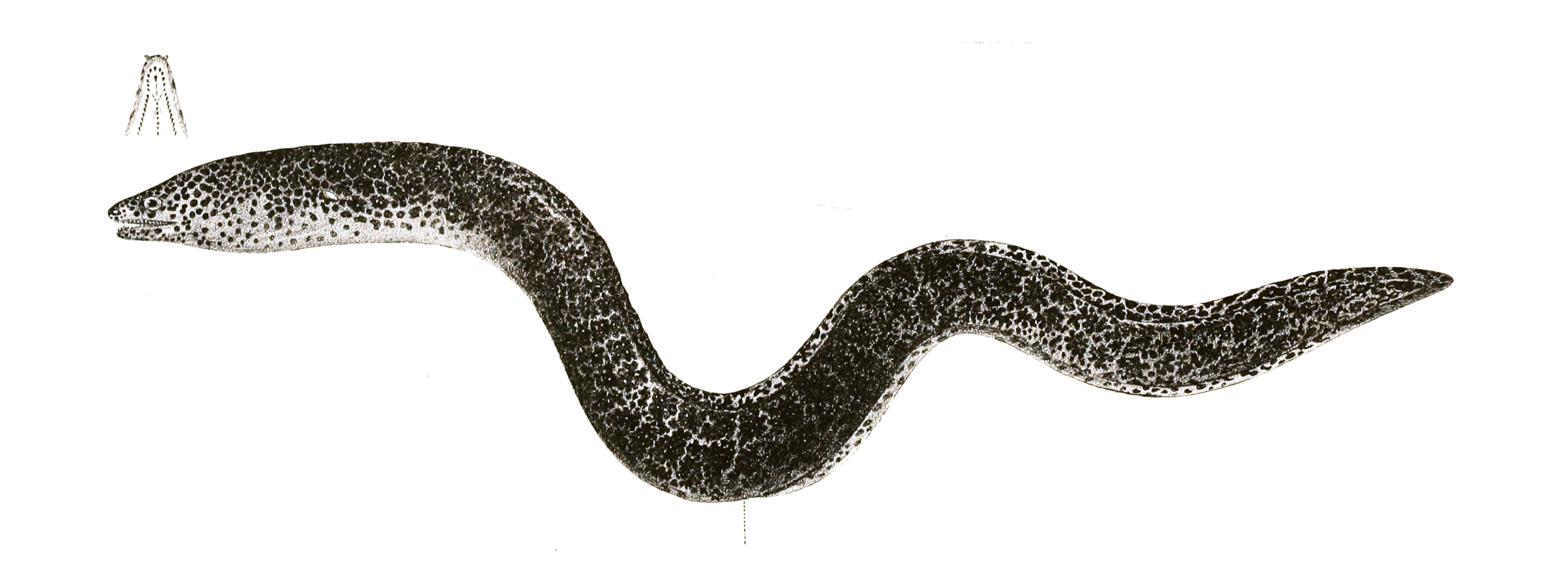Gymnothorax Pictus on:
[Wikipedia]
[Google]
[Amazon]
''Gymnothorax pictus'', the painted moray, paintspotted moray or peppered moray, is a
 The species is pale with purplish speckles, which gather together with age. Young of the species have no spots or bars; they are pale purplish with white bellies. Its maximum length is 140 cm. The peppered moray eats small fish and
The species is pale with purplish speckles, which gather together with age. Young of the species have no spots or bars; they are pale purplish with white bellies. Its maximum length is 140 cm. The peppered moray eats small fish and
moray eel
Moray eels, or Muraenidae (), are a family (biology), family of eels whose members are found worldwide. There are approximately 200 species in 15 genera which are almost exclusively Marine (ocean), marine, but several species are regu ...
. The Chamorro name of the eel is ''títugi''.
Description
 The species is pale with purplish speckles, which gather together with age. Young of the species have no spots or bars; they are pale purplish with white bellies. Its maximum length is 140 cm. The peppered moray eats small fish and
The species is pale with purplish speckles, which gather together with age. Young of the species have no spots or bars; they are pale purplish with white bellies. Its maximum length is 140 cm. The peppered moray eats small fish and crustaceans
Crustaceans (from Latin meaning: "those with shells" or "crusted ones") are invertebrate animals that constitute one group of Arthropod, arthropods that are traditionally a part of the subphylum Crustacea (), a large, diverse group of mainly aquat ...
. ''G. pictus'' is similar to '' Gymnothorax griseus''. While hunting for prey, they may be completely out of the water or may leap out of water. It is dangerous to eat because it is poisonous
A poison is any chemical substance that is harmful or lethal to living organisms. The term is used in a wide range of scientific fields and industries, where it is often specifically defined. It may also be applied colloquially or figurati ...
.
Taxonomy
The peppered moray was named and described by Solander in an unpublished manuscript. Richardson said the fish might be ''Muraena siderea''. Richardson later proved the fish was different by pointing out the difference in coloration. When the names were published as separate species, it was unknown if they were really different species. Kuep gave the species name as ''Sidera pantherina''. Blecker later changed it to its current name. The reason why the name is still the same is because of all three people's work.Habitat
The peppered moray can commonly be found in tropical marine waters of theIndo-Pacific
The Indo-Pacific is a vast biogeographic region of Earth. In a narrow sense, sometimes known as the Indo-West Pacific or Indo-Pacific Asia, it comprises the tropical waters of the Indian Ocean, the western and central Pacific Ocean, and the ...
and from islands of the tropical Eastern Pacific
The Pacific Ocean is the largest and deepest of Earth's five oceanic divisions. It extends from the Arctic Ocean in the north to the Southern Ocean, or, depending on the definition, to Antarctica in the south, and is bounded by the conti ...
. They can also be found in very shallow water on reef
A reef is a ridge or shoal of rock, coral, or similar relatively stable material lying beneath the surface of a natural body of water. Many reefs result from natural, abiotic component, abiotic (non-living) processes such as deposition (geol ...
flats. Places where the species has been found include Suva Reef, the Fiji Islands
Fiji, officially the Republic of Fiji, is an island country in Melanesia, part of Oceania in the South Pacific Ocean. It lies about north-northeast of New Zealand. Fiji consists of an archipelago of more than 330 islands—of which about ...
, Clarion Island
Clarion Island (), formerly Santa Rosa, is the second largest, westernmost and most remote of Mexico, Mexico's Revillagigedo Islands. The island is located west of Socorro Island and just under from the Mexican mainland.
It has an area of an ...
, and the Revillagigedo Islands
The Revillagigedo Islands (, ) or Revillagigedo Archipelago are a group of four volcanic islands in the Pacific Ocean, known for their unique ecosystem. They lie approximately from Socorro Island south and southwest of Cabo San Lucas, the sout ...
.
References
* {{Taxonbar, from=Q2181528 pictus Fish of Hawaii Fish described in 1789 Taxa named by Jonas Niclas Ahl